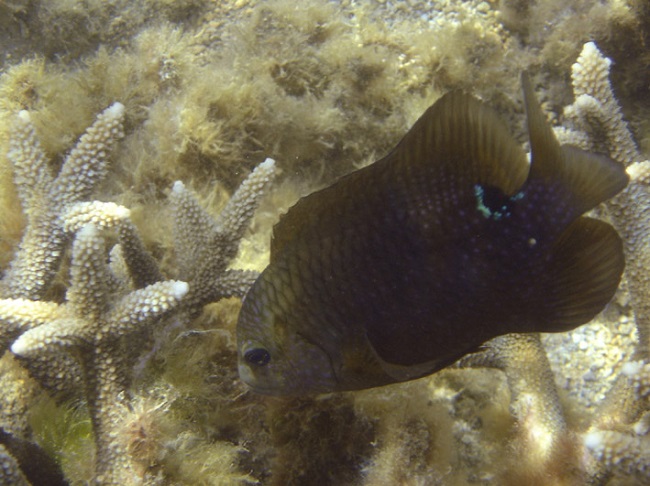Many species of damselfish practice what we may call farming. That is, unlike most herbivores, they do not simply rove about grazing on whatever suitable items they stumble upon; rather, they stake out a territory where there is growth of a desirable algae species, they “weed” the premises by removing undesirable algae species, and they defend the territory from intruders.
Papers published in the journals Biology Letters and BMC Evolutionary Biology, suggest that both the fish and the algae benefit from the relationship. While there are many examples of mutualistic relationships to be found in the marine environment, this particular arrangement is fairly unusual.
Lead author Hiroki Hata (Graduate School of Science and Engineering research scientist at Ehime University) explains that the research team observed the damselfish Stegastes nigricans defending patches of certain species of algae from sea urchins and other herbivorous fish. They also observed the fish removing unwanted algae from the site and dumping it away from their “fields.” Intrigued by the behavior, the researchers later set up experiments that showed that the unwanted algae species would, if not weeded out, eventually overgrow the more desirable algae species. The result was oftentimes a monoculture crop of the damselfish’s preferred algae. Thus, even though the damselfish eats much of the algae, the relationship confers a substantial net gain to the algae.
Damselfishes do not have the necessary organs and enzymes to digest heavily fibrous types of algae. They therefore can only feed on certain algal species (e.g., the red algae Polysiphonia). However, most interestingly, it is not only the algae that benefits from the damselfish’s activities. Numerous small organisms take refuge in the lush algal fronds. For sure, they are ingested along with the plant matter. This mix of plant, animal and microbe, known as an epilithic algal matrix, is likely a highly nutritious diet for the damselfish.
The research team surveyed 320 territories belonging to 18 species of damselfish. The territories were from sites in Egypt, Kenya, Mauritius, Thailand, Borneo, the Maldives, the Okinawa Islands and the Great Barrier Reef.
For more information about the studies, please visit:
http://www.biomedcentral.com/1471-2148/10/185.











Taking a closer look at “#farming” behaviour of #Damselfish http://t.co/NvbMCYf53E #fish